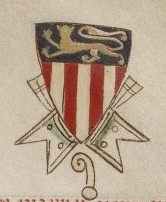William of Savoy facts for kids
Quick facts for kids
William
|
|
|---|---|

Coat of arms of William of Savoy
(Matthew Paris, c. 1255) |
|
| Died | 1239 Viterbo |
| Noble family | House of Savoy |
| Father | Thomas, Count of Savoy |
| Mother | Margaret of Geneva |
William of Savoy was an important bishop from a powerful family called the House of Savoy. He was the son of Thomas, Count of Savoy, and Margaret of Geneva. William died in 1239 in Viterbo, Italy.
He became the bishop of Valence in 1224. William helped arrange royal weddings for queens and was a trusted advisor to Henry III of England. Because of his church jobs and his family connections, he was very influential across Europe, from England to Italy.
Contents
William's Early Life and Church Role
William was at least the fourth son in his noble family. His father, Thomas, wanted William to have important church jobs. These roles would help make the County of Savoy stronger.
By 1220, William was given church benefits in England, thanks to a request to King Henry III. In 1220, he also became the dean of the cathedral in Vienne. Then, in 1225, he was chosen to be the bishop of Valence. He took over from Gérold of Lausanne.
Bishop of Valence and Local Power
As bishop, William had both religious and political power. However, Ademar de Peiteus, the Count of Valentinois, challenged his authority. With help from his family, William defeated Ademar's forces. They then signed a peace treaty in 1231 that was good for William.
Keeping the Savoy Family Together
When their father died in 1233, William's brothers started arguing over parts of the county. In July 1234, the brothers met at Château de Chillon. Some of them brought large armies with them.
William played a key role in keeping the county united under his brother, Amadeus IV of Savoy. The other brothers received important areas under Amadeus's rule. This plan also encouraged them to expand their power outside the county. The treaty they signed said all brothers must fight together if one's land was attacked. William was chosen to settle any disagreements.
William's International Influence
William of Savoy worked hard to arrange for his niece, Margaret of Provence, to marry Louis IX of France. He hoped this marriage would bring more fame and power to his family. William and his brother Thomas went with Margaret to her wedding. However, Louis IX's mother, Blanche of Castile, sent William home with only a few gifts. He was not invited to stay at the French court.
Advisor to the English King
William then worked to have Margaret's younger sister, Eleanor, marry Henry III of England. This plan succeeded, and William traveled with Eleanor to England in 1236. King Henry made William the head of his group of advisors. Henry even wrote to Pope Gregory IX, saying how much he needed William in England.
In August 1236, William was given the Honour of Richmond, a valuable land grant. King Henry then tried to make William the bishop of Winchester. However, the church leaders there did not agree with the king.
In 1237, William helped his brother Thomas, Count of Flanders. He convinced King Henry to release many Flemish merchants. This helped improve trade between England and Flanders. That same year, William also signed a treaty between England and Scotland.
Military Role in Italy
In 1238, Frederick II, Holy Roman Emperor, gathered an army to invade Italy. King Henry chose William to lead 100 knights from Gascony. William was to guide them through the Savoy family's mountain passes in the Alps.
He joined the emperor's army in Turin, Italy. Then he took part in the siege of Brescia. William's bravery during this battle was widely noticed. One writer, Philippe Mousket, wrote that William led his troops on August 23. They drove off an enemy force coming to help Brescia. William and his troops captured 90 knights and 300 foot soldiers. The enemy only captured 5 of William's men.
In 1238, William was also chosen to be the Prince-Bishop of Liège. He died the next year in Italy.


